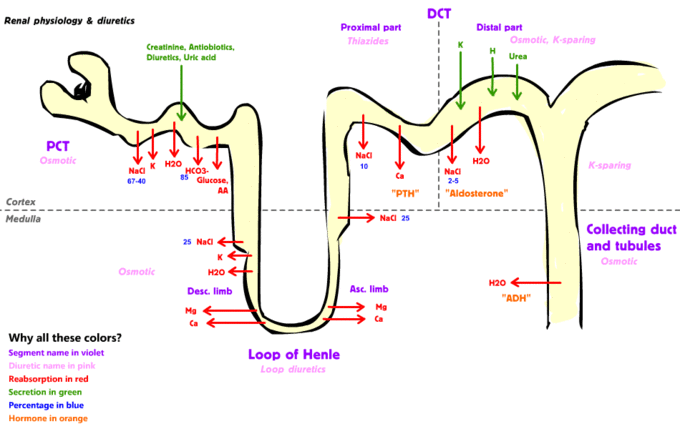Urine is a waste byproduct formed from excess water and metabolic waste molecules during the process of renal system filtration. The primary function of the renal system is to regulate blood volume and plasma osmolarity, and waste removal via urine is essentially a convenient way that the body performs many functions using one process. Urine formation occurs during three processes:
- Filtration
- Reabsorption
- Secretion
Filtration
During filtration, blood enters the afferent arteriole and flows into the glomerulus where filterable blood components, such as water and nitrogenous waste, will move towards the inside of the glomerulus, and nonfilterable components, such as cells and serum albumins, will exit via the efferent arteriole. These filterable components accumulate in the glomerulus to form the glomerular filtrate.
Normally, about 20% of the total blood pumped by the heart each minute will enter the kidneys to undergo filtration; this is called the filtration fraction. The remaining 80% of the blood flows through the rest of the body to facilitate tissue perfusion and gas exchange.
Reabsorption
The next step is reabsorption, during which molecules and ions will be reabsorbed into the circulatory system. The fluid passes through the components of the nephron (the proximal/distal convoluted tubules, loop of Henle, the collecting duct) as water and ions are removed as the fluid osmolarity (ion concentration) changes. In the collecting duct, secretion will occur before the fluid leaves the ureter in the form of urine.
Secretion
During secretion some substances±such as hydrogen ions, creatinine, and drugs—will be removed from the blood through the peritubular capillary network into the collecting duct. The end product of all these processes is urine, which is essentially a collection of substances that has not been reabsorbed during glomerular filtration or tubular reabsorbtion.
Urine is mainly composed of water that has not been reabsorbed, which is the way in which the body lowers blood volume, by increasing the amount of water that becomes urine instead of becoming reabsorbed. The other main component of urine is urea, a highly soluble molecule composed of ammonia and carbon dioxide, and provides a way for nitrogen (found in ammonia) to be removed from the body. Urine also contains many salts and other waste components. Red blood cells and sugar are not normally found in urine but may indicate glomerulus injury and diabetes mellitus respectively.

Normal kidney physiology
This illustration demonstrates the normal kidney physiology, showing where some types of diuretics act, and what they do.